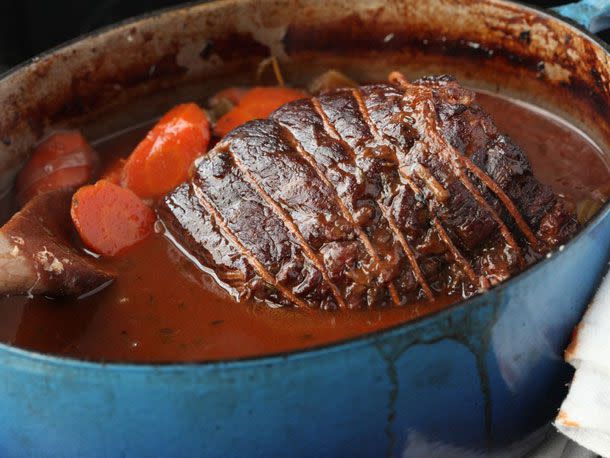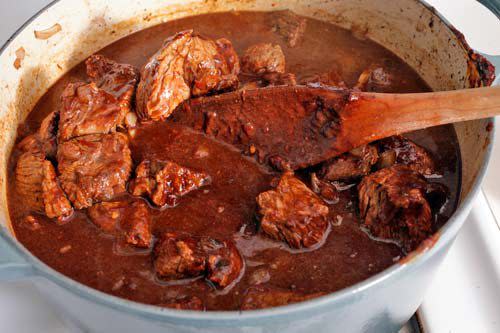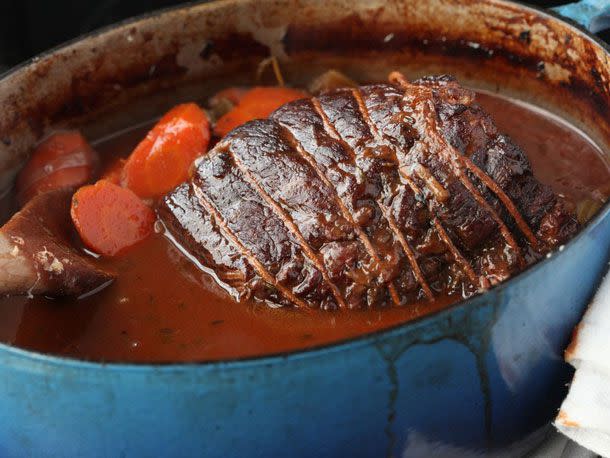How Much Liquid Should I Use When Braising? | The Food Lab
For better sauce and flavor, go easy on the amount of liquid you use when braising meat.

Serious Eats / J. Kenji López-Alt
How Much Liquid Should I Use for Braising?
Many braising recipes I have seen have been very clear about "the braising liquid not covering the meat completely". Any ideas why this is? Does it matter if it covers it completely or not? If it does matter, why??
—Asked by reader GreedyPiglet
The very first time I braised a short rib was when I knew that cooking was going to be my life. Up until then I thought of cooking sort of as putting on make-up. You can change the flavors and the colors of foods, but you wouldn't fundamentally change what's underneath. Braising is the opposite: rather than a mere surface treatment for meat, it's a truly magical transformative process.
What is Braising?
Braising is a low and slow moist cooking process in which tough cuts of meat high in connective tissue are cooked in liquid until that connective tissue breaks down into gelatin, a protein that will subsequently thicken the braising liquid, giving it a rich, mouth-coating texture.
But how much liquid is ideal? Why would a recipe suggest not covering the meat as it braises? What happens if you just simmer the meat?

Serious Eats / J. Kenji López-Alt
The answer comes down to a few things. First and foremost, you have to remember that there are actually two end products with every braised meat dish: the meat, and the sauce.
"The inside of a chunk of meat will not know the difference."
When cooking with moist methods like braising or simmering, the texture of the cooked meat is dependent only on the temperature it was cooked at and the time it was held there. This is the case whether you have it completely submerged in water, whether you cook it sous-vide, or whether you simply braise it in a steamy environment under a lid. The inside of a chunk of meat will not know the difference.
How to Get the Best Sauce While Braising
The sauce's texture, on the other hand, is directly related to the concentration of dissolved gelatin it contains, and its flavor is dependent on the concentration of various flavorful compounds added by the aromatics you cook in it, the liquid you started with, and from the meat itself.
Basically, the more liquid you start with, the more you're going to have to reduce it at the end in order to achieve the desired mouth-coating texture and rich flavor. Short ribs that are cooked completely submerged in liquid will come out with a thin, watery sauce, while those cooked in just a thin layer of liquid—enough to provide a moist environment under your Dutch oven's lid—will produce a rich, flavorful sauce.
In restaurants, these sauces are made even more intense by using gelatin-rich veal stock as the base for the braising liquid. That's why your home-cooked short ribs or osso bucco never has quite the same degree of richness as what you get at a fancy restaurant.

Serious Eats / J. Kenji López-Alt
There's another reason you might consider going easy on the braising liquid: extra color.
Braising and the Maillard Reaction
While it's true that the Maillard reaction—the series of reactions that occur when you sear meat and other protein-rich foods that causes them to turn brown and flavorful—occurs most rapidly at temperatures of several hundred degrees Fahrenheit, they'll still progress at a slower rate even at lower temperatures.
So while browning meat at the beginning of a braise is essential to being that buildup and layering of flavors, you can actually get a good amount of browning on the protruding bits of meat when you braise with only a moderate amount of liquid, which ends up adding a ton of flavor to the finished dish.
So the next time you're filling up that Dutch oven of seared beef chunks with stock for a braise, make sure not to drown the suckers for the best possible final results.
